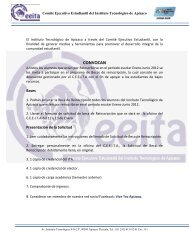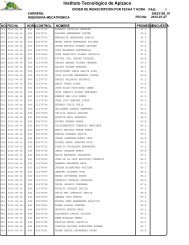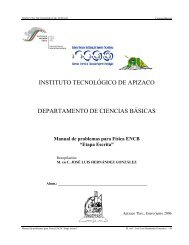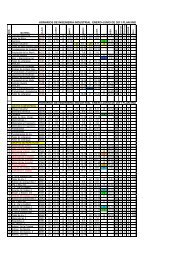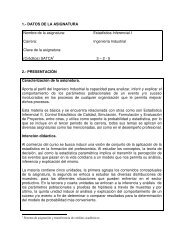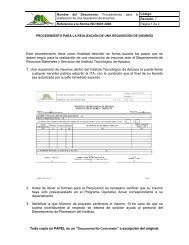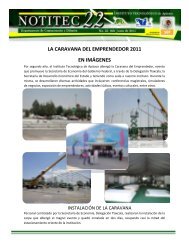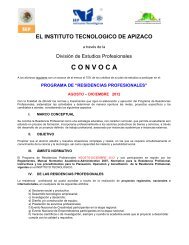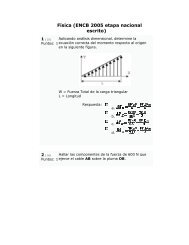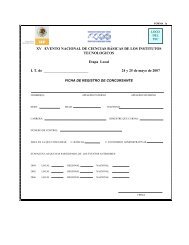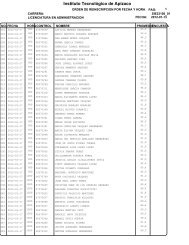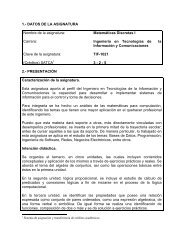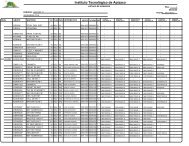1.- IDENTIFICACION DE LA ASIGNATURA Nombre de la asignatura ...
1.- IDENTIFICACION DE LA ASIGNATURA Nombre de la asignatura ...
1.- IDENTIFICACION DE LA ASIGNATURA Nombre de la asignatura ...
Create successful ePaper yourself
Turn your PDF publications into a flip-book with our unique Google optimized e-Paper software.
<strong>1.</strong>- <strong>I<strong>DE</strong>NTIFICACION</strong> <strong>DE</strong> <strong>LA</strong> <strong>ASIGNATURA</strong><strong>Nombre</strong> <strong>de</strong> <strong>la</strong> <strong>asignatura</strong> :Carrera :C<strong>la</strong>ve <strong>de</strong> <strong>la</strong> <strong>asignatura</strong> :Fundamentos <strong>de</strong> InteligenciaArtificialLic. en InformáticaHoras teoría-horaspráctica-créditos :1-3-52. HISTORIA <strong>DE</strong>L PROGRAMALUGAR Y FECHA <strong>DE</strong>E<strong>LA</strong>BORACIÓNInstitutoTecnológico <strong>de</strong>Apizaco, Nov. <strong>de</strong>2006.PARTICIPANTESOBSERVACIONESM.C.Perfecto Este programaMa<strong>la</strong>quias Quintero esta basado en elFloresperfil<strong>de</strong>MIA. Carlos Pérez especialidad enCoronaTecnologíasMC. Orión Reyes Avanzadas <strong>de</strong> <strong>la</strong>Ga<strong>la</strong>vizInformaciónDr. Fe<strong>de</strong>rico Ramírez <strong>de</strong> <strong>la</strong> Lic. EnCruzInformática <strong>de</strong>lLic. Miquelina InstitutoSánchez Pulido Tecnológico <strong>de</strong>Ing. José Antonio Apizaco, <strong>de</strong>finidoCruz Zamoraen julio <strong>de</strong>l2006.3.- UBICACIÓN <strong>DE</strong> <strong>LA</strong> <strong>ASIGNATURA</strong>a) RE<strong>LA</strong>CIÓN CON OTRAS <strong>ASIGNATURA</strong>S <strong>DE</strong>L P<strong>LA</strong>N <strong>DE</strong> ESTUDIOSAnterioresPosterioresAsignatura Temas Asignatura Temas- Todos-TodosSistemasMultiagentesy WebSemánticaSistemasBasados enAgentesTodosTodosb) APORTACIÓN <strong>DE</strong> <strong>LA</strong> <strong>ASIGNATURA</strong> AL PERFIL <strong>DE</strong>L EGRESADO
Conocimientos <strong>de</strong> tecnologías avanzadas <strong>de</strong> <strong>la</strong> informaciónen el Internet.4.- OBJETIVO GENERAL <strong>DE</strong>L CURSOQue el alumno adquiera el conocimiento que fundamenta elestudio, investigación y aplicación <strong>de</strong> <strong>la</strong>s diferentes áreasque conforman a <strong>la</strong> Inteligencia Artificial (IA).5. TEMARIOUNIDAD TEMASSUBTEMASI. Introducción <strong>1.</strong>1 Antece<strong>de</strong>ntes<strong>1.</strong>2 Escue<strong>la</strong>s <strong>de</strong> <strong>la</strong> IA<strong>1.</strong>3 Áreas <strong>de</strong> Estudioe Investigación <strong>de</strong> <strong>la</strong> IA<strong>1.</strong>4 Alcances eImpedimentosII Búsqueda 2.1 Búsquedas Ciegas2.2 BúsquedasHeurísticas2.3 Otras Técnicas <strong>de</strong>Búsqueda y OptimizaciónIIIIVVRazonamientoAutomáticoIngeniería <strong>de</strong>lConocimiento (IC)Introducción alAprendizaje Automático3.1 Introducciòn3.2 Deducciòn Natural enLògica Proposicional3.3 Deducciòn Natural enLogica <strong>de</strong> Primer Or<strong>de</strong>n3.4 Tipos <strong>de</strong> RazonamientoAutomatico3.5 Razonamiento Basado enCasos3.1 Introducción3.2 El Proceso <strong>de</strong> <strong>la</strong>IC3.3 Adquisición <strong>de</strong>lConocimiento3.4 Representación <strong>de</strong>lConocimiento3.5 Ontologías5.1 Introducción5.2 FundamentosMatemáticos5.3 AlgoritmosFundamentales5.4 Aplicaciones6. APRENDIZAJES REQUERIDOS
• Conocimiento <strong>de</strong> <strong>la</strong>s diferentes mo<strong>de</strong>los para <strong>de</strong>sarrollo<strong>de</strong> software e Ingeniería <strong>de</strong> Software.• Conocimiento sobre <strong>la</strong>s características <strong>de</strong> losdistintos tipos <strong>de</strong> sistemas <strong>de</strong> información.• Dominio <strong>de</strong>l lenguaje <strong>de</strong> programación C, C++, Java, yCajas <strong>de</strong> Herramientas <strong>de</strong> Mat<strong>la</strong>b.• Conocimientos sobre los conceptos básicos yherramientas para <strong>la</strong> administración y p<strong>la</strong>neación <strong>de</strong>proyectos.• Conocimientos sólidos en materia <strong>de</strong> ProgramaciónOrientada a Objetos.7. SUGERENCIAS DIDÁCTICAS• Realizar visitas a centros <strong>de</strong> investigación <strong>de</strong>l Paísy <strong>de</strong>l Extranjero que apliquen tecnologías <strong>de</strong>Inteligencia Computacional.• Solicitar al alumno que realice investigaciones enInternet sobre <strong>la</strong>s iniciativas y estado <strong>de</strong>l Arte.• E<strong>la</strong>borar un conjunto <strong>de</strong> casos prácticos.8.- SUGERENCIAS <strong>DE</strong> EVALUACIÓN• Realizar una evaluación diagnóstica para conocer el<strong>de</strong>sempeño académico <strong>de</strong>l estudiante y programar <strong>la</strong>sactivida<strong>de</strong>s <strong>de</strong>l curso.• Establecer <strong>de</strong> común acuerdo con los alumnos <strong>la</strong>pon<strong>de</strong>ración <strong>de</strong> <strong>la</strong>s diferentes activida<strong>de</strong>s <strong>de</strong>l curso.• Realizar trabajos <strong>de</strong> investigación.• Exposición <strong>de</strong> soluciones a problemas reales que tienensignificado para el alumno y que son fruto <strong>de</strong> suiniciativa.• Participación en c<strong>la</strong>se.• Reportes <strong>de</strong> casos prácticos y/o analizados.• Solicitar al estudiante su opinión sobre losresultados <strong>de</strong>l curso.• Exámenes escritos9. UNIDA<strong>DE</strong>S <strong>DE</strong> APRENDIZAJEUnidad <strong>1.</strong> IntroducciónObjetivo Activida<strong>de</strong>s <strong>de</strong> Bibliografía
educacionalEl Alumnocompren<strong>de</strong>rá losfundamentos <strong>de</strong>lparadigma <strong>de</strong> <strong>la</strong>InteligenciaComputaciona<strong>la</strong>prendizaje<strong>1.</strong>1 Investigar enInternet y referenciasbibliográficas el<strong>de</strong>sarrollo <strong>de</strong> <strong>la</strong>InteligenciaComputacional1,2Unidad 2. Computación DifusaObjetivoeducacionalActivida<strong>de</strong>s <strong>de</strong>aprendizajeI<strong>de</strong>ntificara y 2.1 investigar enConocerá losdiferentes fuentes <strong>de</strong>fundamentos <strong>de</strong>l información, losmo<strong>de</strong><strong>la</strong>do <strong>de</strong>diferentes mo<strong>de</strong>losSistemasarquitectónicos <strong>de</strong> losInteligentes Basado sistemas inteligentesen Computación difusosDifusaBibliografía1,3Unidad 3. Computación NeuronalObjetivo <strong>de</strong>aprendizajeActivida<strong>de</strong>s <strong>de</strong>aprendizajeI<strong>de</strong>ntificara y 3.1 investigar enConocerálos diferentes fuentes <strong>de</strong>fundamentos <strong>de</strong>l información,losmo<strong>de</strong><strong>la</strong>do<strong>de</strong> diferentesmo<strong>de</strong>losSistemasarquitectónicos <strong>de</strong> re<strong>de</strong>sInteligentes Basado neuronalesen ComputaciónNeuronal.Bibliografía1,3,4,5,6,7Unidad 4. InteracciónObjetivoeducacionalI<strong>de</strong>ntificara yConocerá losfundamentos <strong>de</strong>lmo<strong>de</strong><strong>la</strong>do <strong>de</strong>SistemasInteligentes Basadoen ComputaciónEvolutivaActivida<strong>de</strong>s <strong>de</strong>aprendizaje4.1 investigar endiferentes fuentes <strong>de</strong>información,losdiferentes algoritmos queconforman el campo <strong>de</strong>estudio <strong>de</strong> <strong>la</strong> ComputaciónEvolutivaBibliografía2,7
Unidad 5. CoordinaciónObjetivo <strong>de</strong>aprendizajeActivida<strong>de</strong>s <strong>de</strong>aprendizajeI<strong>de</strong>ntificara y 4.1 investigar enConocerá los diferentes fuentes <strong>de</strong>fundamentos <strong>de</strong>l información,losmo<strong>de</strong><strong>la</strong>do<strong>de</strong> diferentes mo<strong>de</strong>losSistemasarquitectónicos <strong>de</strong>Inteligentes Sistemas InteligentesHíbridosHibridosBibliografía1,2,3,4,5,6,710. FUENTES <strong>DE</strong> INFORMACIÓN<strong>1.</strong> <strong>de</strong> Castro, Leandro N.; Von Zuben, Fernando J.;RecentDevelopments in Biologically Inspired Computing; I<strong>de</strong>aGroup Publishing, 2004.2. Mohammadian, Masoud; Sarker, Ruhul Amin; Yao, Xin ;Computational Intelligence in Control; I<strong>de</strong>a Group Inc.;2002.3. M. Huth and M. Ryan: Logic in Computer Science:Mo<strong>de</strong>lling and Reasoning about Systems, 2nd Edition,Cambridge University Press, 2004 (H&R).4. Reeves, Colin R.; Rowe, Jonathan E. ; GeneticAlgorithms - Principles and Perspectives : A Gui<strong>de</strong> to GATheory; Kluwer Aca<strong>de</strong>mic Publishers; 2002.5 Steeb, Willi-Hans; Nonlinear Workbook : Chaos, Fractals,Cellu<strong>la</strong>r Automata, Neural Networks, Genetic Algorithms,Gene Expression Programming, Support Vector Machine,Wavelets, Hid<strong>de</strong>n Markov Mo<strong>de</strong>ls, Fuzy Logic with C++, Javaand Symbolic C++ Programs; World Scientific PublishingCompany, Incorporated; 2005.6. Rabunal, Juan, R.; Dorado, Julian; Artifical NeuralNetworks in Real-Life Applications; I<strong>de</strong>a Group Publishing;2005.7. Voges, Kevin; Pope, Nigel; Business Applications andComputational Intelligence; I<strong>de</strong>a Group Publishing; 2005.1<strong>1.</strong> PRÁCTICASPráctica No.1 Realizar el Mo<strong>de</strong><strong>la</strong>do <strong>de</strong> un Sistema Difuso.Práctica No. 2 Realizar el Mo<strong>de</strong><strong>la</strong>do <strong>de</strong> un SistemaNeuronal.Práctica No. 3 Realizar el Mo<strong>de</strong><strong>la</strong>do <strong>de</strong> un SistemaEvolutivo.



